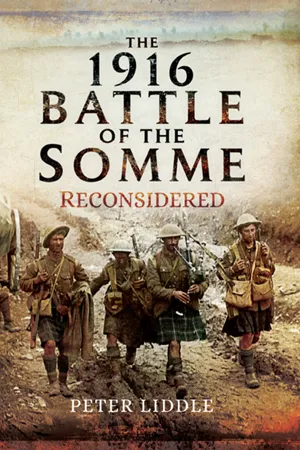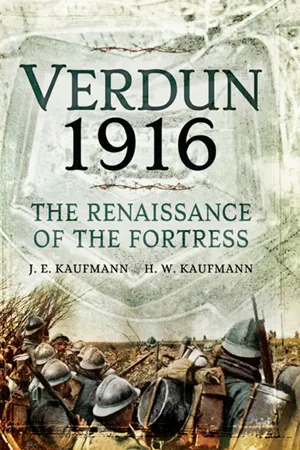Battle of the Somme
The Battle of the Somme was a major offensive of World War I, fought between July and November 1916. It was a joint British and French operation against the German army, and it resulted in heavy casualties on both sides. The battle is remembered for the significant loss of life and the limited territorial gains made by the Allies.
8 Key excerpts on "Battle of the Somme"
- eBook - ePub
Famous Battles and How They Shaped the Modern World, 1588–1943
From the Armada to Stalingrad
- Beatrice Heuser, Athena S. Leoussi(Authors)
- 2018(Publication Date)
- Pen & Sword Military(Publisher)
...All armies learnt considerably from the battle, albeit at very great loss of both men and materiel. Their respective ‘learning curves’ were irregular and inconsistent. Moreover, no army of the Somme perfected a way in which to generate an operational level decision despite the steady incorporation of new technologies and tactics. While air power became increasingly important, artillery continued to be the principal destructive arm. The first British tanks proved little more than a novelty; German guns destroyed many which had not already broken down through mechanical failure. Yet the seeds of armoured warfare planted at the Somme were to sprout in the Second World War when the Somme battlefield was fought over once again in much faster and shorter battles of fire and movement. It is incumbent on military historians to ponder not only on events past, but also to consider their implications for the present and future, and to challenge the popular folklore of a particular nation’s story. Perhaps one of the biggest lessons from the Somme campaign of 1916, and of the First World War as a whole, is the enduring importance of multinational cooperation and cohesion. Hence the results of 23 June 2016 cannot be completely ignored alongside those of 1 July 1916. Yet there is probably another equally fundamental conclusion to be drawn. There remains a vast gap between political rhetoric and reality today over the requirement for strong defences in order to deter war being waged in the first place. The costs of intense and prolonged conflict – as both the world wars of the Twentieth Century amply demonstrate – can be many times more than the required outlays in the years of peace...
- eBook - ePub
The Somme 1916
Touring the French Sector
- David O'Mara(Author)
- 2017(Publication Date)
- Pen & Sword Military(Publisher)
...Chapter Three The Battle of the Somme 1916 Background to the Offensive Originally conceived as part of a war-winning simultaneous strike on three fronts by all Allied nations, initial planning for what was to eventually become the Battle of the Somme began soon after the Italian declaration of war and as early as June 1915, when it was proposed by the French Commander-in-Chief, général Joseph Joffre, that the Allies (France, Russia, Great Britain, Serbia, Belgium and Italy) should begin to operate more co-operatively with each other and co-ordinate their plans accordingly. This proposal was taken up on 7 July 1915 when the first Inter-Allied Military Conference at Chantilly, Oise (the location of Joffre’s Grand Quartier Général) was held. Though no specific actions were decided upon at this conference, it was agreed that concentrated, co-operative actions would be the most successful way forward and the foundations were laid for a second, more proactive, conference to be held later that year. Following on from a meeting in Paris between the British Prime Minister, Herbert Asquith, and his French counterpart, Aristide Briand, on 17 November 1915, an agreement was made and adopted to form a permanent committee co-ordinating action between the two nations. A further Anglo-French meeting was held in Calais on 4 December 1915, presided over by Lord Kitchener, with the French delegation represented by Briand. Two days later, a second Chantilly Conference was held in which the Allied strategy for 1916 was to be decided. Here it was agreed that offensives by the Allied armies on the War Fronts should be delivered simultaneously or, at least, close enough in time to each other (within a month) so that the enemy would be prevented from being able to transport reinforcements from one front to another...
- eBook - ePub
History's Daybook
A History of the World in 366 Quotations
- Peter Furtado(Author)
- 2012(Publication Date)
- Atlantic Books(Publisher)
...I found a few of my men but the majority were still out and most were dead. L IEUTENANT A LFRED B UNDY, 2 ND M IDDLESEX R EGIMENT, 1996. The first day of the Battle of the Somme, 1 July 1916, was the most disastrous in British military history, with almost 60,000 casualties – some 19,500 of them fatalities – sustained in an assault on German lines intended to break the deadlock of trench warfare. A week’s worth of bombardment was supposed to have softened up the German lines enough to allow a decisive breakthrough. Instead, months of attritional warfare continued. The experience of Lieutenant Alfred Bundy, north of La Boisselle, was typical of those who survived the day. The offensive continued until mid-November, when the Allies had advanced a maximum of ten miles. It was a gain, of sorts, but at a cost of over 1 million Allied and German casualties. ALSO ON THIS DAY 1863 US Civil War: the Battle of Gettysburg begins. 1963 The British government confirms Kim Philby had been a Soviet agent. 2007 Smoking is banned in indoor public spaces in England and Wales....
- eBook - ePub
The Road to St. Julien
The Letters of a Stretcher-Bearer of the Great War
- William St. Clair, John St. Clair, John St. Clair(Authors)
- 2004(Publication Date)
- Leo Cooper(Publisher)
...Chapter Eight 1916 The Battle of the Somme Any hopes still harboured by the governments of the belligerent nations, that there might be an easy route to victory in the European War, died in 1915. Despite defeat after defeat, Russia was still in the war, and that meant for Germany the strain of a war on two fronts – the old nightmare of Bismarck. But at least, from the German point of view, it was the German Army that was in the forward positions, holding most of Belgium and parts of France. The British and the French had no such comfort. If their failure in Artois and Champagne was not to be repeated, the scale of the military commitment on the Western Front would have to be enormous. With all the luck in the world, dislodging millions of dug-in Germans could not be done except at terrible cost in men’s lives. Escalation to all-out land warfare on the Continent of Europe appeared the only option. The alternative of using naval power in support of military operations in the east, as advocated by Churchill and Lloyd George, had been tried in 1915. It had ended in the ignominious disaster of the landings at Gallipoli. This failure of Churchill’s Dardanelles Campaign spelt victory for the so-called ‘Westerners’ in the British military establishment, those who thought that Britain’s military resources should be concentrated on the Western Front. And their victory was reflected almost immediately in changes in personnel in the Expeditionary Force. Churchill, having resigned in disgrace in November 1915 over Gallipoli, continued his descent by exiling himself to the Western Front to command a battalion of Scottish infantry, the 6th Royal Scots Fusiliers, of Willie’s 27 Brigade...
- eBook - ePub
- Peter Liddle(Author)
- 2016(Publication Date)
- Pen & Sword Military(Publisher)
...That no fanciful ideas were being entertained of the achievement of a swift, cheap victory was clearly attested on 27 March 1916 by General Joffre, the French Commander-in-Chief, at a conference where the British and the French Prime Ministers were present: ‘We have to destroy the morale of the German Army and nation.’ 1 This was in fact precisely what the German Army was endeavouring to achieve against the French at Verdun with their offensive on that sector now nearly five weeks in operation. The German blow here and an Austro-Hungarian attack on their Italian Front imposed serious constraint upon the Allied plans. In the event, the main burden of carrying out co-terminous offensives fell upon Britain and Russia. The idea, as conceived by Joffre and presented at the end of December 1915 to Sir Douglas Haig, the new British Commander-in-Chief, had been for a huge, 60-mile-frontage, Franco-British offensive on either side of the Somme. Aspects of a developing plan had been discussed and solutions reached when the Germans struck at Verdun in late February, destroying in a blow the scale of the Allied intention. The compromise reached may be categorised as the retention of the French idea but in larger measure to be fulfilled by the British. Clearly there was a need for Britain to play an increased role in operations on the Western Front. In Britain’s New Armies there was an uncommitted resource and France, where manpower resources were fully stretched already, was now being subjected to a massive new onslaught. By no statistical comparison had Britain’s military effort in Flanders and France been on a scale to earn equality of voice in Anglo-French military deliberations. France now expected the evident imbalance of commitment to be redressed. This, and anxiety over Verdun, drew all French thinking concerning the appropriate location for the belated British contribution, aouth to the Somme...
- Colonel John Buchan(Author)
- 2014(Publication Date)
- Verdun Press(Publisher)
...CHAPTER IV. — THE Battle of the Somme: THE BUTTE DE WARLENCOURT. — (July—December 1916.) The Brigade attached to the First Army—In the Trenches at Vimy —The Difficulties of the Later Stages of the Battle of the Somme—The Country around the Butte de Warlencourt—The Brigade enters the Line at Eaucourt l’Abbaye—The Attack of 12th October—The Capture of the Pimple—The Attack of 18th October—The Fighting of the 18th and 19th —The Brigade withdrawn to the Arras Area—General Lukin takes Command of the 9th Division. AFTER the fight at Longueval and Delville Wood the 9th Division left the Somme and was transferred from the XIII. Corps in the Fourth Army to the IV. Corps, under Lieutenant-General Sir Henry Wilson, in Sir Charles Monro’s First Army. The South African Brigade marched to Maricourt on 23rd July, where it entrained for Hengest, and on the 27th arrived in the Frévillers area, north of the main road between Arras and St. Pol. Here its first task was reorganization. Drafts to the number of 40 officers and 2,826 other ranks had been sent from Bordon during July, and their training had to be completed before they could be absorbed into the different regiments. {14} On 5th August, the Army Commander, Sir Charles Monro, inspected the Brigade, which at the moment showed a parade strength of 62 officers and 2,523 men. On the 11th the King visited Frévillers and walked down the village street, which was lined by the 1st Regiment in fatigue dress. By the third week in the month the Brigade was sufficiently rested and reconstituted to take its place once again in the front line, and on 23rd August it took over from the 26th Brigade the Berthonval and Carency sections of the Vimy area. At that date the Germans held the crown of the celebrated ridge, and the British front ran along its western slopes...
- eBook - ePub
- Brig.-General Francis A. Maxwell V.C.(Author)
- 2015(Publication Date)
- Lucknow Books(Publisher)
...Cathedral. Figure 163 Three wounded British soldiers, one drinking from a bowl, in a dressing station in a churchyard at Morlancourt, near Albert. Figure 164 Troops outside a coffee stall, Auchonvillers, November 1916. Figure 165 Albert Basilica Figure 166 Sausage Valley Somme August 1916 Figure 167 The Somme battle Figure 168 A heavy howitzer on the Somme Figure 169 Battles of the Somme. An Artillery Sergeant’s Mess near their gun. Mametz Wood, July 1916 Figure 170 British Mark I Tank at The Somme Figure 171 The Battle of the Somme Figure 172 Retaken German trench WW1 Battle of the Somme Figure 173 The Battle of the Somme Figure 174 Regiment men in dugouts Battle of the Somme August 1916 Figure 175 British gas attack Somme June 1916 Figure 176 German trench gun in action on the Somme Figure 177 Cheshire Regiment trench Somme 1916 Figure 178 Wounded at the battle of Somme Figure 179 The Battle of the Somme Figure 180 The Battle of the Somme Figure 181 The Battle of the Somme Figure 182 - Burial at a Somme Cemetery Figure 183 - Contalmaison Chateau Cemetery and ruins of the Chateau just after the. war. Figure 184 - Delville Wood just after the War Figure 185 - Butte de Warlencourt shortly after the War Figure 186 -The main Albert road through Le Sars shortly after the War Figure 187 -The ruins of Guillemont Station Figure 188 - The site of Guillemont village during the War Figure 189 - Graves in Trônes Wood. Figure 190 - The 18th Division Memorial by Trones Wood just after the War Figure 191 - A machine-gun post in Trônes Wood just after the War Figure 192 - The Ruins of Combles Figure 193 - Mine Crater at la Boiselle just after the War. Figure 194 - A blockhouse in Pozières after the war. Figure 195 - The ruins of Thiepval village. Figure 196 - A German Gun Destroyed By Our...
- eBook - ePub
Verdun 1916
The Renaissance of the Fortress
- H. W. Kaufmann, J. E. Kaufmann(Authors)
- 2016(Publication Date)
- Pen & Sword Military(Publisher)
...Chapter Four The Battle of Verdun, 1916 ‘Victory must be ours …’ From a letter by a young German soldier who died only a few weeks after the war began Happy New Year Like two exhausted boxers, the Germans and the French armies rested to recuperate from their wounds and prepare for another round at the end of 1915. This time, both formulated actions for 1916 with every intention of delivering a knockout blow. The optimum time to begin a campaign is in the spring, after the thaw and the rains. Winter weather is the least desirable time for an offensive, especially when it involves trench warfare. General Joffre planned for concentric operations with his allies, which required him to wait until the summer for the Russians to be ready. However, he was prepared to go into action as early as April if the Russians were attacked. Since the Germans had remained on the defensive in the West throughout 1915, Joffre assumed that they would repeat this strategy in 1916. General Falkenhayn, however, had no intention of waiting for the spring since he believed that time was running out for Germany to achieve a decisive victory. Joffre could not afford a repeat of 1915. The morale of the French troops improved, especially when generals like Pétain took steps to improve conditions on the front, gave them leave and provided them with postal services. Ordinary citizens, except those in the occupied lands, had not suffered too much. The Poilu’s equipment and gear had improved. Despite the loss of valuable resources at Briey and Lille, French industry managed to increase production and the USA, which remained neutral, supplemented France’s needs. Above all, the French fought on their soil against an invader and patriotism still ran strong. However, losses like those incurred in 1915 could spell disaster for the war effort...





![The History Of The South African Forces In France [Illustrated Edition]](https://img.perlego.com/books/RM_Books/inde_pub_group_sqonxaw/9781782893769_300_450.webp)
![Frank Maxwell Brig-General, V.C., C.S.I., D.S.O. - A Memoir And Some Letters [Illustrated Edition]](https://img.perlego.com/books/RM_Books/inde_pub_group_sqonxaw/9781786255488_300_450.webp)
